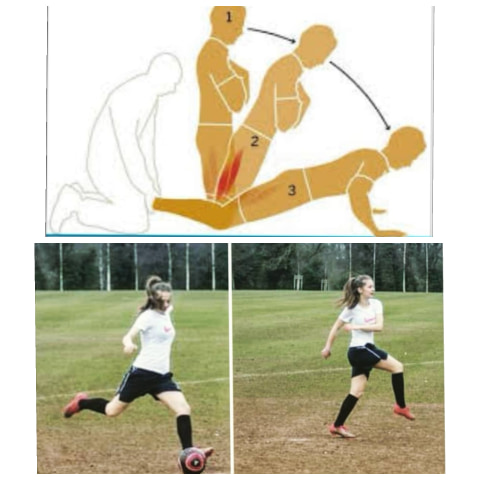Soccer is characterized as a high intensity, intermittent contact team sport that requires a number of proficient physical and physiological capabilities to perform successfully. Soccer players not only require highly developed technical and tactical skills, but high levels of aerobic and anaerobic conditioning, speed, agility, strength and power as well. One area that soccer players tend to neglect is strength development. Years ago, soccer teams relied on general strength only, with no emphasis on soccer specific strength. Fortunately, technological and scientific research advancements have helped push training to new levels in the development of the total player, including strength (Gatz, 2009).
Maximal strength and explosive power of the legs are important components for soccer performance. Hoff & Helgerad (2004) found that low repetition high resistance training improved sprinting velocity and jumping height in elite soccer players. Wisloff et al., (2004) have shown that maximal strength in half squats determines sprint performance and jumping ability in high level soccer players. Moreover, exercises such as bar squats, leg press exercises and simulated kicking exercises improve powerful kicking performance by raising muscle activation patterns during critical phases of the kick (Manopoulos et al, 2013). According to Hensen et al (2015), hip adduction strength training, using elastic bands induced a relevant increase in eccentric hip adduction strength which can prevent groin injuries. Additionally, Serner et al. (2014) found that the Copenhagen adduction exercise can have similar results.
Interestingly, Askling et al., (2003) found that pre-season hamstring strength training (1 to 2 times per week) including eccentric overloading, would be benefitial for elite soccer players, both for injury prevention and performance enhancement. Mjolsnes et al., (2004) found that eccentric strength training with Nordic hamstring curls reduces the incidence of hamstring strains.
The hamstrings are a complex of 3 posterior lower body muscles (biceps femoris, semitendinosus, semimembranosus) that combine to serve as both primary extensors of the hip and flexors of the knee (Shoenflield, 2010). These muscles are highly involved in all activities that require running, cycling, and jumping, thus substantial hamstring strength and power are essential in numerous athletic endeavors.
Hamstring muscle injury is the most common muscle injury across a range of different sports. Eccentric hamstring strength is a fundamental etiological factor associated with hamstring muscle strains. Eccentric muscle contractions are seen not only as an integral part of the functional repertoire of the hamstring muscle group but also as a key factor related to injury potential.
Mjolsnes et al (2004) found that the NHE was more effective in developing maximal eccentric hamstring strength than the traditional hamstring curl exercise in well trained soccer players.
Small et al, (2009) found that performing eccentric hamstring strengthening exercises during the cool down rather than the warm up of soccer training sessions more effectively maintains eccentric hamstring strength.
A study conducted by Petersen et al., (2011) showed that by intervening with one simple exercise, the NHE, in a progressive 10 week program, acute hamstring injuries could be reduced by 70%. Additionally, re injuries alone reduced by 85% in the group that performed the Nordic exercise program.
A systematic review and meta analysis by Dyk et al., (2019) showed that teams using NHE (in isolation or as a part of a larger injury prevention program) reduced hamstring injury rates up to 51%. The value of eccentric training and the NHE is recognized at elite level football.
However, the adoption of the exercise into regular training programs is poor, and the overall use of the NHE in other sports is not known.
